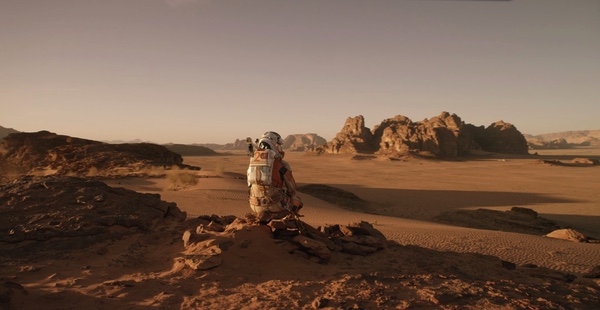Where is the dream?by Dwayne Day
|
| The 1970s were a time when the future ceased being a promise and started to seem more like a threat. |
Recently the podcast “Every Single Sci-Fi Film Ever” noted that after the 1968 film 2001: A Space Odyssey, by the early 1970s, science fiction movies seemed to move away from rocketships and spaceflight and towards inward-looking dystopian visions of the future, often set on a wasted Earth. In The Omega Man, most of humanity has been wiped out by chemical weapons. In Soylent Green, humans are eaten as food. In Silent Running, humanity has sent its last forests into space, and then blows them up. In Logan’s Run, humans don’t live past 30. Arguably, this dystopian earthbound trend started a bit earlier, but it was in full swing by the time Apollo ended, carried along by cultural trends more powerful than the waning excitement of the Space Age.
Of course, in 1977 Star Wars completely changed the dynamic and made spaceships cool again, but setting aside that the film was as much fantasy as science fiction, very few of the space-based films that followed Star Wars had a positive message or an uplifting vision of the future or spaceflight. Close Encounters of the Third Kind in 1978 and Star Trek: The Motion Picture in 1979 were more positive, but 1979 was also the year that Alien premiered, presenting a bleak vision of future spacefaring: the crew of the Nostromo was not exploring strange new worlds, they were hauling ore in a dirty spaceship. Soon other sub-genres of science fiction also took hold, like dozens of earthbound knockoffs of Mad Max depicting post-apocalyptic wastelands often filmed in a junkyard to save money. The 1970s were a time when the future ceased being a promise and started to seem more like a threat.
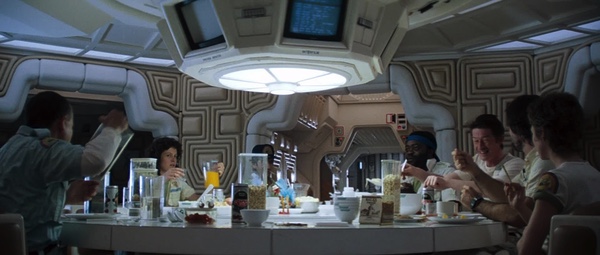 The 1979 movie Alien depicted the crew of the space tug Nostromo, nearly all of them die horribly. At a time when some visionaries were writing about the industrialization of space, Alien and other films did not make it very appealing. Movies and television shows about space travel are rarely positive and optimistic. (credit: 20th Century Fox) |
The future dream of spaceflight is a nightmare
Author Kevin J. Anderson has said that “science fiction isn’t about predicting the future. Science fiction is about inspiring the future.” That’s not really true, because so much science fiction has warned about negative futures, or merely used them as a setting for an entertaining (or lame) story—monsters and aliens come to threaten us. Alex Blechman joked on Twitter in 2021 about a science fiction author who said that “In my book I invented the Torment Nexus as a cautionary tale,” and then a tech company would brag “At long last, we have created the Torment Nexus from classic sci-fi novel Don’t Create The Torment Nexus.”
Science fiction was not always or consistently positive, but by the second decade of the Space Age, the future was no longer a happy place, and space seemed particularly hostile, even if there are no aliens. An overriding theme in science fiction for many decades now is that spaceflight is not really a good thing. At best, we still bring our human problems with us, at worst, space is hostile and empty. But space, and spaceflight, do not make us better people.
This negative pop culture view of spaceflight was in ascendance at the same time that a “pro-space” movement was gestating. Starting in the 1970s, space advocates embraced a positive future of “living and working in space.” In 1976, Gerard K. O’Neill published The High Frontier: Human Colonies in Space. It was followed in 1977 by two other books: Stewart Brand’s Space Colonies, and T.A. Heppenheimer’s Colonies in Space. Most Americans had no problem with the word “colonization” because the country’s colonial experience was in the distant past and was generally positively viewed as prelude to the creation of the American nation—although if you asked a Native American what they thought about colonization, you’d probably get a much different answer. But many other parts of the world have a bad experience with “colonialism,” viewing it as an exploitative relationship that they suffered under, sometimes into the 1970s, with lingering effects all the way to the present. American space enthusiasts took note and started using the term “settlements” instead of “colonies,” although some still remained oblivious or indifferent to the negative connotations of the word.
The 1970s visions of a future in space usually included an industrial component, a concept of building something in space that could benefit humans on Earth, such as solar power satellites. Perhaps most relevant to today, as a boy Jeff Bezos was entranced by the vision of moving polluting industries off-world, one of the inspirations for his company Blue Origin—the name is a reference to humanity’s home planet. Another major theme during the 1970s was mining planetary bodies for resources, such as platinum group metals.
Themes of space industrialization have not fared well in popular culture since visionaries like O’Neill pushed them into the zeitgeist. Take, for example, the subject of space mining. Over several decades there have been a handful of companies that have proposed mining asteroids for resources. Some of them are defunct, others technically still exist, but none of them are less than decades away from operations, let alone making a profit. There have also been companies that have proposed mining resources on the Moon.
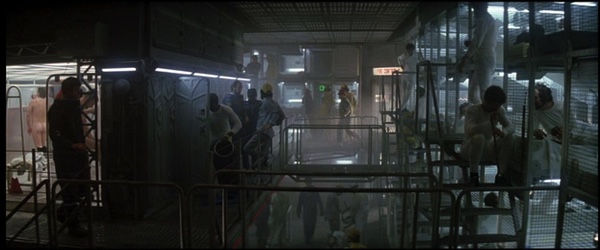 The 1981 movie Outland depicted a mining facility on a moon of Jupiter. The miners live in miserable conditions and many of them die. (credit: Warner Brothers) |
But in popular culture, space mining has never been portrayed positively. Alien had a crew of space truckers hauling an ore refinery and working for an evil corporation that considered them expendable. Except for Ripley and the cat, they all die. The 1981 movie Outland had Sean Connery as a lawman investigating the deaths of workers at a mine on Jupiter’s moon Io; they’re hopped up on amphetamines to make them work harder for a soulless corporation more interested in production rates than death rates. The 2009 movie Moon depicted automated helium-3 mining on the lunar surface overseen by a person who didn’t exactly live a happy existence or work for a nice company. The books and recent TV series The Expanse depicted residents of the asteroid belt who live miserable lives mining resources for an over populated Earth. The two Avatar movies have also not so subtly depicted the miners as raping an alien planet and killing its native inhabitants.
To be sure, you would be hard-pressed to find a positive depiction of current-day terrestrial mining. Nobody romanticizes coal or copper mining, and some gold and diamond mining operations in Africa are essentially slavery by another name. But unlike space, nobody is claiming that terrestrial mining is part of a positive future in the way that some space advocates claim that mining the solar system is the solution to Earth’s problems.
| There have still been big budget science fiction movies, including so-called “hard sci-fi” that have attempted to be more realistic, but even these movies have depicted spaceflight in a negative light. |
Similarly, space settlement has long been a focus of space enthusiasts. This goes back at least to the L5 Society of the 1970s and then the National Space Society that exists today. Elon Musk’s advocacy for a city on Mars is not very complex or sophisticated. He mainly sees it as an insurance policy in case something bad happens to Earth, ignoring the reality that it is far easier for bad things to happen on Mars. Musk often talks about a settlement on Mars with the explicit, and untested, assumption that there are hundreds if not thousands of people who want to go there right now. The Mars One proposal that gained much attention in 2015 was actively seeking settlers to go to the red planet before it all fell apart.
But space settlement is also not portrayed positively in popular culture. The 1986 movie Aliens and the more recent Alien: Romulus both depicted space colonies as awful places to live (neither used the word “settlement”). The Expanse did not depict space settlements as wonderful places—mostly their inhabitants were resource-starved and miserable. The Martians, at least, were committed to improving their lives and their planet, but they were already living lives of hardship. Other recent big budget science fiction films such as Dune and Dune Part Two featured environmentally devastating exploitative colonial societies. Arrakis isn’t paradise, and eventually produces a messiah who goes on a terrible rampage.
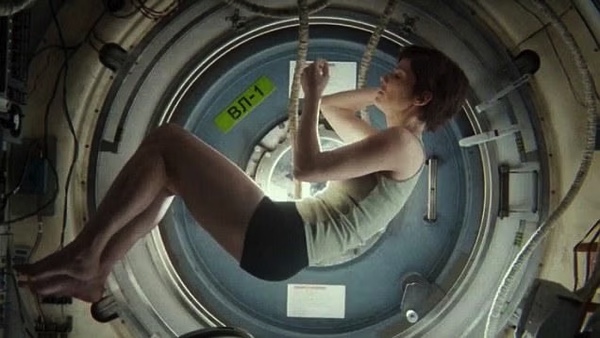 The 2013 movie Gravity starts with the statement “Life in space is impossible” and ends with the heroine being reborn on Earth. Most movies about spaceflight depict it as dangerous and the environment is hostile. (credit: Warner Brothers) |
Space is danger
Many other science fiction movies of the past few decades have used spaceflight as a plot device primarily to create havoc. Armageddon and Deep Impact may have shown astronauts saving the Earth from total destruction, but many cities got blown up in the meantime. Similarly, aliens have come down from space to attempt to wipe out humanity in many other films, such as Independence Day in 1996 (and its 2016 sequel), and War of the Worlds in 2005. A consistent theme in film is that space is a threat to humanity, not its salvation.
Science fiction has waned a bit in popular culture, largely replaced in the last two decades by superhero/comic book films and television shows that are sci-fi adjacent, but share more in common with fantasy and mythology. There have still been big budget science fiction movies, including so-called “hard sci-fi” that have attempted to be more realistic, but even these movies have depicted spaceflight in a negative light. The 2013 movie Gravity opened with the printed words “Life in space is impossible”—not exactly subtle—and depicted Sandra Bullock as an astronaut struggling to survive after her entire crew is killed. The film is about depression and rebirth, subsumed within a powerful anti-space message.
Around the same time was Elysium, which depicted a wondrous city in space that was clearly inspired by the 1970s visions of giant space stations. But the main theme of the film was that Earth was terrible and the rich fled to their space stations—not the kind of message that inspires dreams (unless you’re rich enough to afford them). Christopher Nolan’s movie Interstellar had a tag line that “Mankind was born on Earth, it was never meant to die here.” The movie’s protagonist is a former astronaut who goes into space to save humanity from a dying Earth. Although that would seem to be a very pro-space message, Earth is already doomed, and the film mostly depicts spaceflight as depressing and hostile. It is also very difficult from a storytelling standpoint, if not hypocritical, to depict space as a positive place in contrast to an environmentally devastated Earth.
 The Avatar movies—the third is due out this year—have depicted space colonization as brutal and destructive, a far cry from the romanticism of space enthusiasts. (credit: 20th Century Fox) |
Red planet blues
There have been numerous movies and TV shows about humans traveling to Mars to set up outposts (and eventually settlements), but their stories have often been mixed at best, bleak at worst. The 2000 film Mission to Mars ended with an astronaut climbing aboard an alien spaceship to head off to the stars, which was somewhat inspiring even if it was essentially taken from Close Encounters. That same year Red Planet debuted. It was primarily an action film where the unlikeable astronauts die, with Val Kilmer’s character finally blurting out “Well, that’s about it. I hate this planet.” Stuffed into the film was a minor plot device involving Martian bugs that could possibly save Earth from environmental devastation, a rare case where space was not only a threat, but a possible source of salvation. But if you blinked, you missed that part.
More complicated was the National Geographic series Mars, which aired its first season in 2016 and its second in 2018. The first season was devoted to the establishment of an initial outpost on Mars, whereas the second took place ten years later and focused on a conflict between scientists and capitalists. Those themes could have been interesting and inspiring, but instead almost all the characters were miserable or malicious. Mars was not a positive depiction of a journey to the red planet. But it is also unlikely that many people even watched the show.
Perhaps of all the recent depictions of space travel, the most important is the 2015 movie The Martian, where Matt Damon plays an astronaut struggling to survive by growing potatoes, in you know what. Although it is a heroic survival story, the movie is about individual innovation and perseverance in a hostile environment, not about how great space exploration is.
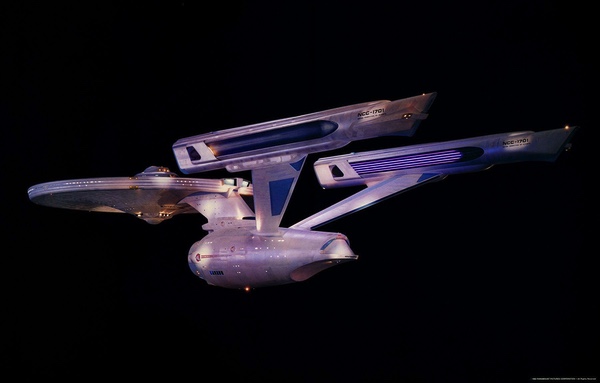 Star Trek has often been cited as an optimistic vision of the future and space exploration. But much of Star Trek, particularly in its more recent incarnations, has focused on action, danger, and war, largely abandoning Gene Roddenberry's utopianism. (credit: Paramount) |
The final frontier
The show that has been most cited in the past as presenting a positive vision of humanity’s future in space is Star Trek. When it premiered, it was unique. Contemporary shows like The Outer Limits and The Twilight Zone were darker and more menacing, and up until then much science fiction consisted of monsters and alien invaders. Star Trek, according to some, was popular because it presented a future where humans had achieved peace and were exploring the galaxy.
| Much of Star Trek has not been positive, however, depicting future wars and referring to several world wars that humanity has endured (meaning that in the Star Trek timeline, our near future is horrible). |
Gene Roddenberry, Star Trek’s creator and visionary, went on speaking tours during and after the original show’s late 1960s run and talked about the show’s vision and why he thought it was popular with fans. Roddenberry said at the time that Star Trek showed a future where humans had solved most of their problems, and celebrated diversity. But Star Trek at the time did not show them solving those problems or overcoming their prejudices, that had already magically happened at some time before Kirk and Spock set out exploring strange new worlds.
Next year will be Star Trek’s 60th anniversary, and the franchise has consisted of nearly a dozen shows, over 800 episodes, and 13 movies. Much of Star Trek has not been positive, however, depicting future wars and referring to several world wars that humanity has endured (meaning that in the Star Trek timeline, our near future is horrible). More recently, televised Star Trek has been darker. The current iteration, Strange New Worlds, has had some positive and uplifting episodes, but also some dark ones. In the last episode of its last season, space settlers were being eaten by humanoid lizards, not learning to coexist with them.
Movie commenter Sonny Bunch has noted that several recent films such as Avatar: the Way of Water, Lightyear, and Strange World also are not very positive about space. “Human exploration is out,” Bunch wrote in a Washington Post op-ed, “human exhaustion is in.” The characters in those movies were not exploring new worlds but hunkering down on the ones where they were already at. “Films once championed the idea of discovery and expansion. But pop culture has become too skeptical and depressed about the future of humanity to envision bold moves into the unknown. Instead, our storytelling has retreated into prosaic domestic concerns.” Arguably, those movies are not really critiques of space exploration as they are of exploitation and colonialism. But the fact remains that they don’t depict space exploration in a positive light. Bunch also noted that Elon Musk was then spending less time on his space and environmental visions and more time on cultural and political fights, something that only increased since Bunch wrote about it in January 2023.
Perhaps the one counter example has been the Apple TV+ show For All Mankind, which over three seasons has sought to project space as a challenging but interesting place to explore and settle, with benefits for humanity in the form of advanced technology and energy resources. Like The Expanse, however, it features plenty of conflict (often the same problems dragged up from Earth), and death, and season four is reportedly going to depict conflict between Earth and Mars. Arguably, it is the most positive depiction of spaceflight in recent science fiction. But it is also reaching only a tiny audience—less than a failed Marvel movie—limiting its influence on popular culture.
No matter where you go, there you are
Drama requires conflict. It is not surprising that so many science fiction movies and television shows feature evil corporations, murderous androids, collisions and depressurizations and dangerous aliens. Science fiction is by now a mature genre, and many of its early unique concepts have become mundane, tired. Some creators in the science fiction genre have also been critical of how dystopian it has become and called for creating a more positive vision of the future. A recent Kickstarter by Habitats Press sought to raise money for a collection of short stories “celebrating optimism in science fiction and fantasy” to “explore wonder, adventure, and the boundless possibilities of tomorrow,” a response to the dark universe that so much science fiction now traverses. But there is little indication that the genre is changing overall. At least for film and television, science fiction is mostly grim, and its portrayal of spaceflight is not optimistic.
So how can a positive vision for real spaceflight long endure when the fictional, cultural message about spaceflight is consistently negative, even hostile?
Maybe the two are not really connected.
| Much of spaceflight enthusiasm isn’t really a philosophy, more a form of entertainment, like watching a football game. People flock to watch rocket launches, especially big ones like Starship, not because they dream of living on Mars, but because these are unique and spectacular events. |
Space enthusiasm shares many characteristics with religion—attempting to achieve immortality by moving humanity off a doomed Earth, appeals to transcendence, or species improvement through the creation of new societies and political structures. There are similarities between space enthusiasts and past utopian movements. Space enthusiasm seems to have persisted at low level despite the negative depictions of spaceflight in popular culture. But space enthusiasm doesn’t seem to have expanded in scope in recent decades. There’s no pro-space political movement, for example (we’ll see how the new America Party evolves.) One form of it that is popular among tech moguls is a form of “longtermism,” a utopian future that helps justify their accumulation of wealth and ambitious projects.
Much of spaceflight enthusiasm isn’t really a philosophy, more a form of entertainment, like watching a football game. People flock to watch rocket launches, especially big ones like Starship, not because they dream of living on Mars, but because these are unique and spectacular events, demonstrations of engineering accomplishment, or at least impressive fireworks displays. They’re cool. And just like there are people who watch car races for the possibility of a crash, some people probably watch rocket launches because they may blow up. Most of the people who go (or view it online) want to watch the rocket, not ride the rocket.
There is another more specific aspect of spaceflight enthusiasm that largely exists independent of popular culture—imaginary world-building. The internet is ripe with fervent discussions of plans to send Starships to Mars. Beyond the prolific sniping, there is also rampant speculation and semi-informed daydreaming as enthusiasts critique Elon Musk’s plans while fervently advocating their own blueprints for Mars settlements. There are plenty of enthusiastic keyboard engineers arguing about rocket thrust, propellant rates, and the cost of supplying millions of tons of liquid oxygen to multiple launch sites. Some of these participants may become actual engineers and technicians participating in efforts to make their daydreaming into reality. Most are content at holding down more mundane day jobs while engaging in internet battles in their spare time.
But they won’t get much support from Hollywood. In space, no one can hear you dream.
Further reading
“It’s the end of the world as we know it (and I feel fine),” The Space Review, July 7, 2025; “Life in space is impossible,” The Space Review, May 19, 2014; “Is a dream a lie if it don’t come true?” The Space Review, May 1, 2017; “In space, no one can hear you dream,” The Space Review, February 15, 2016; “Forces of darkness and light,” The Space Review, December 10, 2018; “Red planet rumble,” The Space Review, August 17, 2015.
For more on recent Mars-themed TV shows, see: “Reality is underrated: Fox’s Stars on Mars takes off,” The Space Review, July 10, 2023; “Red planet reality,” The Space Review, May 30, 2023; “Red zeitgeist: popular entertainment and the settlement of Mars, part 3,” The Space Review, January 16, 2017; “Love and a Red Planet: popular entertainment and the settlement of Mars (part 1),” The Space Review, November 28, 2016; “Red Planet blues: popular entertainment and the settlement of Mars (part 2),” December 5, 2016; “Mars: Bringer of ennui (part 1),” The Space Review, January 21, 2019 and “Mars: Bringer of ennui (part 2)”, January 28, 2019; “Mars ain’t the kind of place to take your kid: Netflix’s ‘Away,’” The Space Review, October 5, 2020; “Red zeitgeist: popular entertainment and the settlement of Mars, part 3,” The Space Review, January 16, 2017.
“For All Mankind” has been discussed several times in The Space Review, such as here, here, here, here, here, and here.
Note: we are now moderating comments. There will be a delay in posting comments and no guarantee that all submitted comments will be posted.
